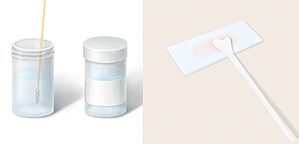When You Have an Abnormal Pap Test
The Pap test is a screening test that checks for cell changes in the cervix, the opening of the uterus. If your Pap results were abnormal, you may be worried. But there is no reason to panic. An abnormal Pap test result can mean many things. It may be due to changes (inflammation) caused by normal cell repair or infection. Or you may have a problem that could become cervical cancer. If so, know that early stages of cervical cancer tend to progress slowly. That's why it's so important to have Pap tests as often as directed. Pap tests can show cell changes in the cervix early, when treatment is most effective.

Cervical cells are put into a fluid or on a slide and sent to a lab for evaluation.
Be sure to discuss your results with your healthcare provider. Find out about any follow-up tests you'll need. You may be asked to come back for a second Pap test in a few months. Or, you may be scheduled for an exam so your healthcare provider can get a closer look at your cervix. In either case, be sure to keep your follow-up visits. They are one of your best safeguards against future problems.
Understanding Your Risk
Some lifestyle choices can increase your risk of abnormal cell changes. Did you start having sex at a young age? Have you had many sexual partners? Have you had sex without using a latex condom? Do you smoke? If you answered yes to any of these questions, you are more at risk. One of the most common reasons for an abnormal Pap result is infection with the human papillomavirus (HPV). If your Pap results suggest HPV, further testing may be needed.
The Pap Test
For 2 days before your Pap test, don't douche, use vaginal creams, or have sex. During the test:
-
An instrument called a speculum holds the vagina open. This lets your healthcare provider see the cervix.
-
A small brush or swab is used to take cells from several areas of the cervix. The cells are put into a liquid or on a slide. They are then sent to a lab where they are studied for changes. Your healthcare provider will contact you with the results.